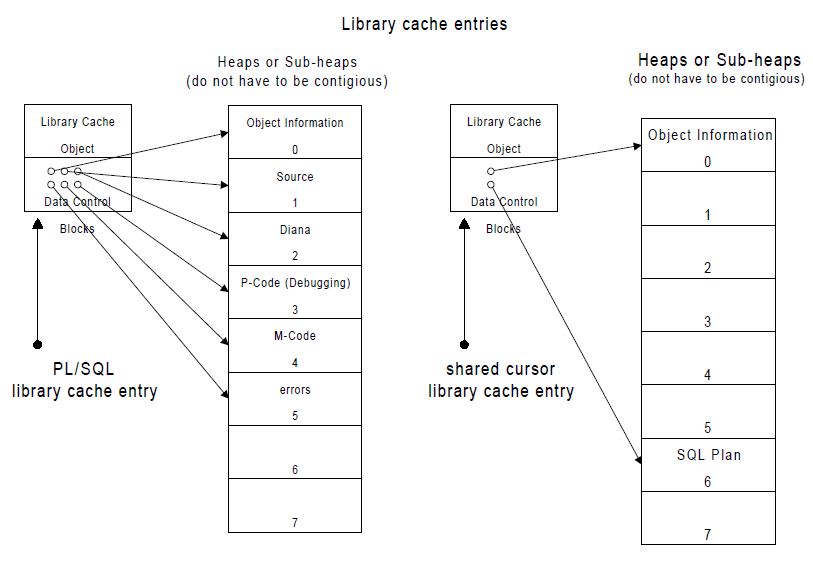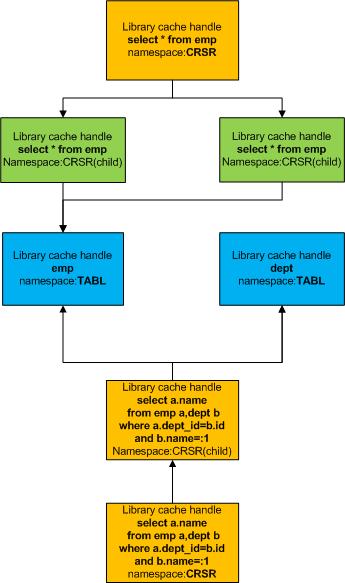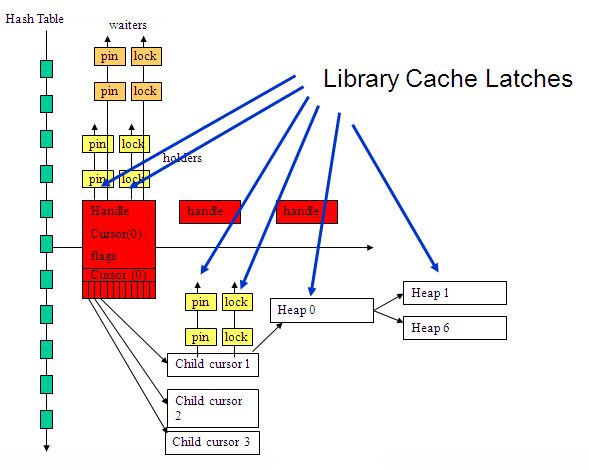Library cache是Shared pool的一部分,它几乎是Oracle内存结构中最复杂的一部分,主要存放shared curosr(SQL)和PLSQL对象(function,procedure,trigger)的信息,以及这些对象所依赖的table,index,view等对象的信息。
原理与buffer cache中定位block的方式相同,将对象信息(比如SQL)hash定位到某个hash bucket中,然后顺序扫描bucket中的 List,实现快速定位对象的目的。Library cache handle是对象的一个指针,其中的namespace属性表示其指向的对象的类型:比如CRSR(Cursor),TABL(Table),INDX(Index) ,PROD(Procedure),TRIG(Trigger)等等。LCO(Library cache object)是handel指向的对象,包含了以下几个部分的内容:
1.dependency table:指向本对象所依赖的对象,比如:select * from emp这个cursor的对象,依赖emp这个表,这里指向了emp这个表的handle。
2.child table:指向本对象的子对象,比如某个游标的子游标。子游标是指SQL文本相同,但是SQL的实际含义不同的情况,比如执行的用户不同,执行计划不同,执行的环境不同等等,我们一般称之为SQL的不同版本。一个SQL至少包含一个父游标和一个子游标。
3.authorization table:对象的授权信息。
4.typeLibrary cache object的type,包括:shared cursor,index,table,cluster,view,synonym,sequence,procedure,function,package,table body,package body,trigger等等。
5.data blocksdata block是一个指针,指向了data heap,即存放真实数据的地方,主要包括:diana tree, p-code, source code, shared cursor context area等等,如下图:
 Library cache对象依赖关系:
Library cache对象依赖关系:对象依赖关系是利用LCO中的dependency table来完成的,我们设想以下的情况,用来说明对象间的依赖关系:两个共享游标:SQL1: select * from emp;SQL2: select * from emp和select a.name from emp a,dept b where a.dept_id=b.id and b.name=:1;

SQL1产生了两个子游标,也就是SQL文本相同的两个不同版本,他们同时依赖emp表。SQL2只有一个版本,因为每个游标最少有一个子游标,所以它只有一个子游标,并且同时依赖dept表和emp表。
Library cache中的并发控制:Oracle利用Library cache lock和Library cache pin来实现并发控制,Library cache lock是在handle上获取的,而Library cache pin则是在data heap上获取。访问对象时,首先必须获取handle上的lock,然后将访问的数据pin在内存中。lock的作用是控制进程间的并发访问,而pin的作用是保证数据一致性,防止数据在访问时被交换出去。Library cache lock有三种模式:null,share,exclusive,Library cache pin有两种模式:share,exclusive。下面详细解释在修改和访问对象时,lock和pin的作用:
修改对象:编译SQL或PLSQL对象,获取该对象(cursor,procedure)handle上exclusive类型的lock,并且持有data heap上exclusive类型的pin,防止其他人读取和修改。同时,在该对象所依赖的对象(table)上,必须持有一个share类型的lock和pin,防止在修改的过程中,被其他进程所修改。
访问对象:访问SQL或PLSQL对象,获取该对象(cursor,procedure)handle上NULL类型的lock,并且持有data heap上share类型的pin,同时,在其依赖的对象(table)上持有share类型的lock和pin。如果一个procedure依赖另外一个function,那么在被依赖的function上,也需要持有share类型的lock和pin。NULL类型的lock比较特殊,它只存在于cursor和procedure等只读对象上,它并不起到任何并发控制的作用,它更象是一个trigger,当对象失效时,通知所有访问这个cursor的进程。比如:select * from emp这个SQL,依赖emp表,当emp表发生变化时,cursor上的NULL lock被打破,所有有访问这个cursor的进程都会知道该对象已经失效。当持有对象的library cache pin时,会在row cache中对相应的对象加锁,就是row cache lock,阻止可能导致数据字典信息混乱的DDL发生。

lock和pin的实现类似于enqueue,在每个handle上都有lock和pin的holder list和waiter list,用来保存持有该资源和等待该资源的队列。
阻塞分析:现实情况中,我们有一个数据库中存在被应用大量频繁访问的procedure,当依赖的表发生变更时,导致该procedure失效,这时会出现大量的library cache lock和library cache pin的等待,堵塞应用访问,造成了重大故障。出现这个问题的原因是:当procedure失效后,所有访问该对象的进程都尝试去编译,大量进程尝试获取exclusive类型的lock和pin,出现了大量的等待。后续的Oracle版本作出了改进,当出现这种情况时,只允许第一个进程尝试去编译该对象,编译通过后,所有的进程就可以并发访问,避免了大量进程同时尝试编译的情况出现。
Library cache中的Latch:Library cache中相关的latch包括:shared pool latch,library cahce latch,library cache lock latch,library cache pin latch。Share pool latch的主要作用是分配或释放空间时使用,从Oracle9i开始,sharedpool被分成了很多个subpool,由多个shared pool latch保护,Oracle开始支持更大的shared pool。Library cache latch的主要作用是在hash bucket中定位handle时使用,library cache lock latch和library cache pin latch分别是获取lock和pin时,需要取得的latch。shared pool大小不合理,大量的硬解析以及SQL版本过多都可能导致shared pool latch和library cache latch的争用。从Oracle10g开始,Oracle正在逐步用mutex取代library cache中的latch,cursor:pin S和cursor:pin X相当于share和exclusive类型的library cache pin,cursor:pin S wait on X则表示share方式正在等待exclusive锁定。